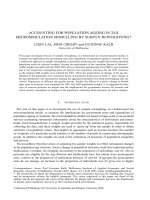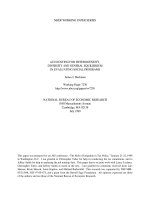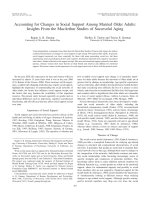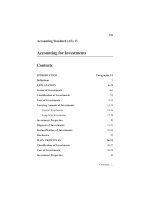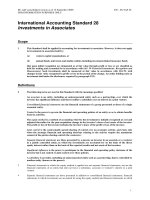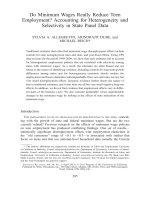Accounting for investments in derivative financial instruments
Bạn đang xem bản rút gọn của tài liệu. Xem và tải ngay bản đầy đủ của tài liệu tại đây (147.05 KB, 47 trang )
Appendix 17A:
Accounting for Investments in
Derivative Financial Instruments
ASC 815 (FAS 133)
Understanding derivatives
a. Forward Contract:
Gives holder the right and obligation to purchase
an asset at a preset price for a specified period of
time.
Example:
Dell enters into a contract with a broker for
delivery of 10,000 shares of Google stock in
three months at its
current price of $110 per share. =>
$1,100,000
Dell has received the right to receive 10,000 shares in
three months and incurred an obligation to pay
$110
per share at that time.
Understanding derivatives
b. Option Contract:
Gives the holder the right, but not the obligation, to buy
share at a preset price for a specified period of time.
Example:
Dell enters into a contract with a broker for an option
(right) to purchase 10,000 shares of Google shares at its
current price of $110 per share.
The broker charges $3,000 for holding the contract open for
two weeks at a set price.
Dell has received the right, but not the obligation to
purchase this stock at $110 within the next two weeks.
Concept of Derivative Instruments
The forward contract and the
option contract both involve a
future delivery of stock.
The value of each of these contracts relies on the underlying
asset –the Google stock.
Therefore, these financial instruments (the FORWARD and
the OPTION contracts) are known as derivatives because
they derive their value from values of other assets
(e.g., Google stocks or other stocks or bonds or commodities).
Or, their value relates to a market –determined indicator
(e.g., interest rates or the S&P’s 500 index).
Who uses derivatives?
a. Producers and consumers: Hedgers
Example:
Heartland –Large producer of potatoes
McDonald –Large consumer of potatoes (French fries)
The objective is not to gamble on the outcome or to profit
but to lock in a price at which both of them obtain
an acceptable profit.
Both companies, the producer and the consumer, are hedgers.
They hedge (protect) their positions to ensure an acceptable
financial outcome.
b. Speculators and arbitrageurs: Speculators
The objective is to gamble on the outcome or to profit based
on the outcome.
Why use derivatives?
-Changes in the price of jet fuel:
Delta, Continental, United….
-Changes in interest rates:
Citigroup, AIG, BoA…..
-Changes in exchange rates:
GE, GM, Cisco …..
Accounting guidelines for derivatives (ASC 815)
a. Recognized as assets and liabilities.
b. Reported at fair value.
c. UNREALIZED Gains and losses from speculation in
derivatives recognized in income immediately.
d. UNREALIZED Gains and losses from hedge transactions
reported in accordance with the type of hedge
either in OCI or income.
Derivative financial investment -Speculation.
Call option: Gives the holder the right, but not the obligation,
to buy shares at a preset price (strike price or exercise price).
A company (speculator) can realize a gain from the increase
in the value of the underlying share with the use of a Call
Option – a derivative.
Example: A company enters into a call option contract on
January 2, 2007, with Baird investment Co., which gives it the
(referred to as the notional
option to purchase 1,000 shares
amount) of Laredo stock at $100 per share. On January 2nd, the
Laredo shares are trading at $100 per share. The option
expires on April 30, 2007. The company purchases the call
option for $400.
If the price of Laredo stock increases above $100, the
company can exercise this option and purchase the
shares for $100 per share.
If Laredo’s stock never increases above $100 per share, the
call option is worthless.
Derivative financial investment -Speculation.
Accounting entries:
(1) To record purchase (option premium) of call option:
Call Option
Cash
400
400
The option premium consists of two amounts:
Intrinsic Value & Time value
*Option premium = Intrinsic value + Time value;
(a)Intrinsic value = Preset strike price - Market price
On January 2, the intrinsic value is ZERO because
the market price equals the preset strike price.
(b)Time value is estimated using an option-pricing model.
It reflects the possibility that the option has a fair value
greater than zero. WHY?
Because, there is expectation that the price of Laredo shares
will increase above the strike price during the option term.
On January 2, the time value of the option is $400.
Derivative financial investment -Speculation.
(2) FYE Adjustments: March 31, 2007:
a. To record increase in intrinsic value of option:
On March 31, 2007, Laredo shares are trading at $120 per share.
Therefore, the Intrinsic Value of the Call Option is now:
$20,000 = $120,000 – $100,000.
This gives the company an unrealized gain of:
$20,000 = $20,000 - $0.
The company records the increase in intrinsic value as follows:
Call Option
20,000
Unrealized Holding Gain or Loss—Income
20,000
Derivative financial investment -Speculation.
(b) To record decrease in time value of the option:
On March 31, 2007, a market appraisal indicates that
the time value of the option is $100.
This gives the company an unrealized loss of $300:
$300 = $400 - $100
The company records this change in time value as follows:
Unrealized Holding Gain or Loss—Income
300
Call Option
300
Derivative financial investment -Speculation.
(4) To record the settlement of the call option contract with
Baird on April 1, 2007:
On April 1, 2007, the company exercises the call option
(simultaneously buys and sells) and records the settlement
of the call option with Baird as follows:
Cash (120,000 – 100,000 = net cash)
Loss on Settlement of Call Option
Call Option
20,000
100
20,100
Derivative financial investment -Speculation.
Effects of the call option on net income:
Date
Transaction
Income (Loss) Effect
March 31, 2007 Net increase in value of call option
April 1, 2007
Settle call option
Total net income
$19,700
(100)
$19,600
Derivative financial investment -Speculation.
Financial statement reporting:
(1)Call option is reported as an asset at fair value.
(2) Any gains or losses (unrealized or realized) are
reported in income.
Put Option
An option contract giving the owner the right,
but not the obligation, to sell a specified amount
of an underlying security at a specified price
(STRIKE PRICE) within a specified time.
A put becomes more valuable as the price of
the underlying stock depreciates (falls) relative
to the strike price.
This is the opposite of a call option.
Derivatives Used for Hedging –FV Hedge
Put Option
Example:
On March 1, 2007, you purchased a March 08 Taser 10 put.
That means, you have the right to sell 100 shares of Taser at
$10 until March 2008 (usually the third Friday of the month).
If shares of Taser fall to $5 and you exercise the option, you
can purchase 100 shares of Taser for $5 in the market and sell
the shares to the option's writer for $10 each, which means
you make $500 = (100 x ($10-$5)) on the put option.
Note that the maximum amount of potential profit in this
example ignores the premium paid to obtain the put option.
Exercise 20
Exercise 19 (HW)
Exercise 21 (HW)
Three basic characteristics of Derivative Instruments(FAS 133)
1. The instrument has one or more underlyings and an
identified payment provision.
2. The instrument requires little or no investment at the
inception of the contract.
3. The instrument requires or permits net settlement.
Three basic characteristics of Derivative Instruments(FAS 133)
1. The instrument has one or more underlyings and an identified
payment provision.
An underlying is a specified stock price, interest rate, commodity
price, index of prices or rates, or other market-related variable.
The interaction of the underlying, with the face amount or the
number of units specified in the derivative contract (the notional
amounts), determines payment.
Example:
The underlying is the stock price of Laredo stocks.
The value of the call option increased in value when the value of
the Laredo stock increased.
Payment Provision = Change in the stock price x Number of Shares
Three basic characteristics of Derivative Instruments(FAS 133)
2. The instrument requires little or no investment at the
inception of the contract.
Example:
The company paid a small premium to purchase the call option –
an amount much less than if purchasing the Laredo shares as a
direct investment.
3. The instrument requires or permits net settlement.
Example:
The Laredo stock Call Option allows the company to realize a
profit on the call option without taking possession of the shares.
This Net Settlement feature reduces the transaction costs
associated with derivatives.
Derivatives Used for Hedging
Hedging is the use of derivatives to reduce Price risk, interest
rate risk and exchange rate risk.
(1) Interest rate risk is risk that changes in interest rates will
negatively affect the fair-values or cash flow of interest
sensitive assets and liabilities.
(2) Exchange rate risk is the risk of foreign exchange rates
negatively affecting profits.
SFAS 133 (ASC 815) establishes accounting and reporting
standards for derivative financial Instruments used in hedging
activities.
The FASB allows two types of hedges:
a. Fair Value Hedges;
b. Cash Flow Hedges.
Derivatives Used for Hedging –FV Hedge
a. Fair value hedge:
A derivative used to hedge (offset) the exposure to
changes in the fair value of a recognized asset or liability,
or of an unrecognized commitment.
In a perfectly hedged position, the gain or loss on the
fair value of the derivative equals and offsets that of the
hedged asset or liability.
(1) Interest rate swaps: Used to hedge the risk that changes
in interest rates will have a negative impact on fair value
of debt obligations.
(2) Put options: Used to hedge the risk that an equity
investment will decline in value.
Derivatives Used for Hedging –FV Hedge
Accounting for a Fair Value Hedge -Put option:
Example:
On April 1, 2006, Hayward Co. purchases 100 shares of
Sonoma stock at a market price of $100 per share.
Hayward does not intend to actively trade this
investment. It consequently classifies the Sonoma
investments as available-for-sale (AFS).
On December 31, 2006, Sonoma shares are trading at
$125 per share.
Derivatives Used for Hedging –FV Hedge
(a) Hayward records this AFS investment as follows on 4/1/2006:
AFS Securities
10,000
Cash
10,000
(b) On December 31, 2006, Sonoma shares are trading at $125 per
share.
Following the rules of FAS 115, Hayward records AFS securities at
FMV on the Balance sheet and reports unrealized gains and losses in
equity as part of Other Comprehensive Income:
AFS Securities
Unrealized Holding Gain (loss) –Equity
2,500
<=(125–100)*100
2,500
Derivatives Used for Hedging –FV Hedge
(c) Balance Sheet presentation of the Sonoma Investment
on 12/31/2006:
Assets
Available-for-securities (at FMV)
Shareholders’ Equity
Accumulated other comprehensive income
Unrealized Holding Gain (loss)
$12,500
$2,500


